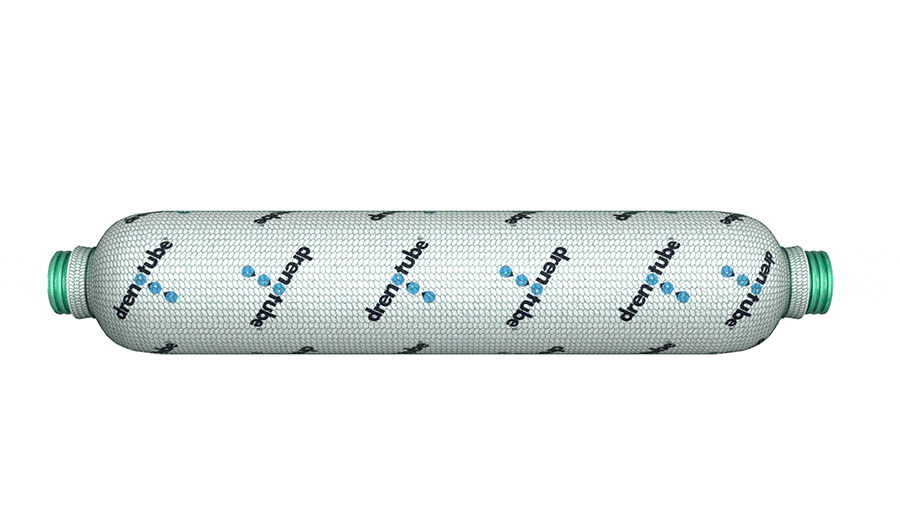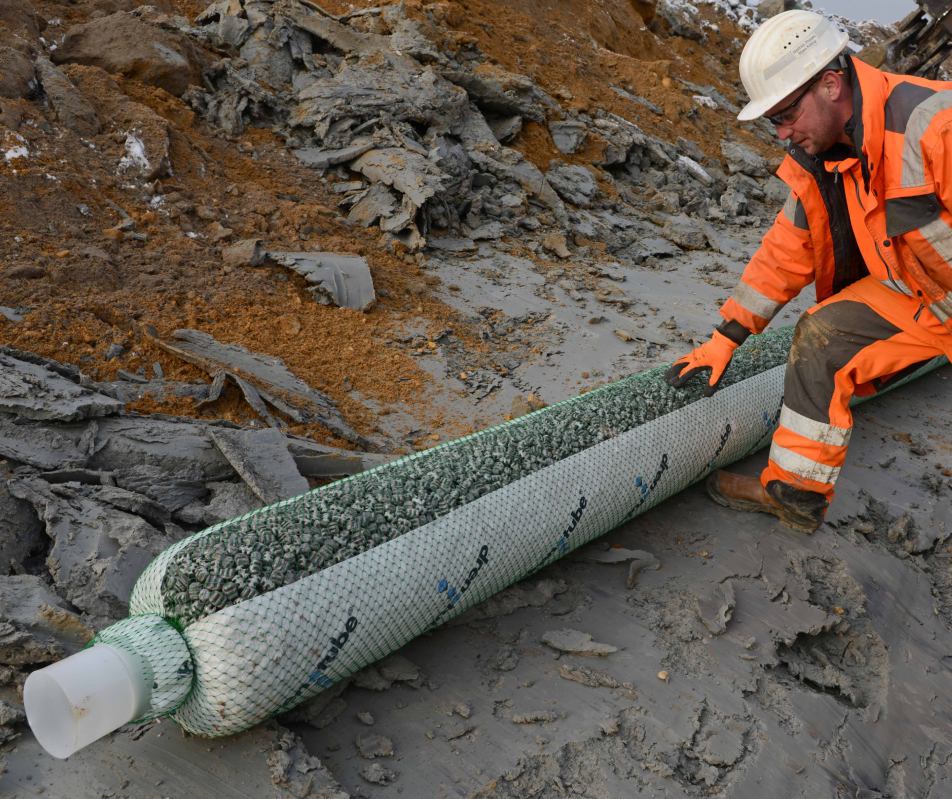Pre-assembled drainage and infiltration system
Sectional view of the modular unit drenotube®.
Product «3 in 1» Drain Pipe - Synthetic Gravel - Geotextile.

Our Solutions
Drainage
Infiltration
Drainage tube
Corrugated slotted 6-row

Infiltration tube
3 rows perforated Ø 15 mm

drenotube® is a geocomposite that offers solutions for soil drainage and infiltration. Preassembled drainage segments consist of a double wall slotted corrugated pipe surrounded by a geosynthetic aggregate enclosed in a high strength polyethylene netting that is clamped to both ends of the pipe. Includes a fabric geotextile filter in between the netting and aggregate.


Quality controls
Drenotube® is subject to strict quality controls. All modules are labeled with a serial number and meet the certifications:
-CE European Evaluation EAD 280001-00-0704 ETA 15/0201
-FDES Life Cycle Assessment NF EN 15804 + A1

Modular system
Modules of 3m and 6m in length are manufactured to facilitate the installation and to allow manual transport to the site. Each tube includes a fast click-fit connector.

Geosynthetic aggregate
Geosynthetic particles replace conventional gravel, eliminating the need to add more gravel. They are specially designed with channels to achieve a higher flow and water retention capacity. Made out of 100% EPS recycled material.

About us
Fumoso Industrial is a family owned company leader in the production of expandable polystyrene raw materials. It was established in 1965 at early days of EPS – In year 2012 we started with the production of drenotube® subsurface drainage and infiltration pipe systems. With more than a decade of experience in pre assembled drainage and infiltration systems the product has perfected and accredited by hundreds of installation in more than 15 countries worldwide.
Frequently Asked Questions
Drenotube® is also designed to be used in light live weight traffic applications. As an additional measure to guarantee that the pipe will not collapse under preassure we suggest to use Drenotube® SN8 (ring stiffness) references rather than SN4
Another good practice is not to disturb the consolidated soil by adjusting the excavation width of the trench to the Drenotube® diameter plus 5 to 10 cm only excavating a parallel walls trench (not a truncated cone).
Pressure acting (transferred) on Drenotube® underground pipes depends on:
Pressure caused by the weight of the soil above the Drenotube® + hydrostatic pressure caused by the weight of the water above the Drenotube® + pressure caused by the live transport load on surface of the soil
Paved surfaces help to distribute and hence reduce live weight traffic pressure acting at the bottom of the trench (as a general rule at least divide by 2)
Figures of a live weight traffic reduction according to depth when backfill soil is compacted by layers (non paved surface):
@ 0,5 m depth pressure is reduced by 25%
@ 1 m depth pressure is reduced by 60%
@ 2,5m depth pressure is reduced by 90%
Yes it is possible to cut Drenotube® to a desired length using two long zip ties. Mark the place to cut and wrap the ties all around at each side of the mark. Distance from the tie to the mark 30 cm. (between ties 60 cm).Tighten the ties and cut by the mark. Remove excess beads. Retie the zip ties.
The maximum depth should not exceed 5 metres. The minimum backfill cover is 30 cm.
Subsurface drainage lines are often perforated and wrapped in geotextile or buried in a granular filter bed, and serve to carry water to the weep holes from areas deeper within the backfill. Hydrostatic pressure force the water through the bottom of the pipe, which effectively lowers the water level in the trench.
With the holes down the water will flow out of the pipe when installed and surrounding water will immediately percolate into the pipe through the holes and flow out of the pipe when it is installed with a fall.
Advantages:
* Water percolates quicker into the pipe
* Faster drainage.
* With the pipe perforation up only the area above the pipe holes will drain into pipe.
* For a 110 mm diameter pipe, the minimum drainage level in a totally perforated pipe it is at least 50 mm lower. Hence the required trench depth for a TP pipe is 50 mm less.
** Holes facing down if you want to drain as much water as possible.
** To avoid fines sediment settling in the bottom of the pipe it is better to use a pipe with a higher flow rate. It is a TP pipe.
Yes, roots look for water and can damage any drainage system. If necessary use herbicides and sub-surface screen foils to avoid roots from coming into the pipe. Use the same techniques as for a traditional drainage.

